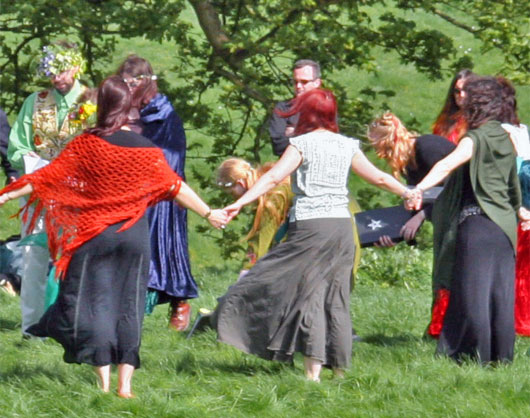(…I couldn’t come up with a word that began with “P” that meant “circle”, but I was pretty committed when I got to the end of the title.)
Typically, when people think about ritual and religious substitutes, it’s common to mirror the Judeo-Christian tradition. This comes with some baggage that we may not even think of as baggage – lining people up in rows, putting them before one person-or-small-group who stand in front of them, and tell them what to do and think about.
There’s some good reason for this – it’s hard to otherwise fit a lot of people in a room, and at first glance your community can’t grow if you acquire more people.
But in the past year, I was exposed to Atheopaganism. Atheistic pagans – drawing from the pagan aesthetic but treating gods as metaphors – have been around for a while. But there’s a new push to grow them as a movement. And it’s got me thinking.

Pagans seemed to have optimized less for rapid growth and more for “having a particular kind of ritual/community/culture.” Quakers seem like a Christian-lineage culture with the similar focus. They both tend to orient around a circle rather than rows of pews. Some ideas this points at:
- Power structure. If you have a large organization you need some kinds of structure to run said organization. But within a ritual itself, there’s also a power structure (conceivably divorced from the organization’s). Preachers and Pews creates a hierarchy where people are limited in how much they can shape the ritual.
- Having people form a circle creates an atmosphere that is more shared, more reminiscent of “gathered round a campfire”, and more conducive to creativity and spontaneity.
- There’s an obvious problem with flat power structure – random people can drag it in a direction people find boring, annoying or offensive. How big a problem this is depends on how well people know each other and what group norms you have.
I could see a completely leaderless ritual working with up to 20 people (easier with 4-7) if everyone trusts each other. If there’s not uniform trust, I could see 10-40ish person rituals working if there’s a leader who’s job is “facilitator” rather than “leader”, who is good at their job.
This requires some critical mass of people who want to shape the ritual in some way, and those people either having enough skill to do so, or having a ritual designed in such a way that less skilled people can have fun/meaning with it.
Ritual components that may lend themselves well to this sort of thing, and/or examples to draw from. These don’t necessarily require a physical-circle-shape to the people, but it may help.
- If people have a shared body of music, you can have people take turns suggesting songs people already know (or request that people perform, in the way Filk and Folk circles do).
- Improvisational dance or music that doesn’t require everyone to face a projection screen.
- You could have a ritual centered around building something. Start with a vague goal and a bunch of materials, and the ritual can be about creating something together. (Alternately, you could start by building an altar or sacred space, and then using it to do a second half of the ritual)
I’d be interested in experimenting in this direction, and in hearing how other experiments in this direction have gone.